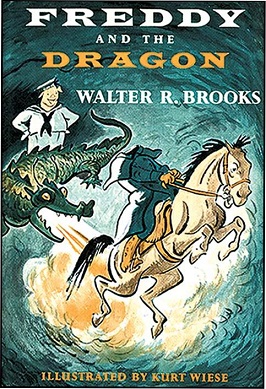Freddy and the Dragon facts for kids

First edition - The dragon confronts the headless horseman
|
|
| Author | Walter R. Brooks |
|---|---|
| Illustrator | Kurt Wiese |
| Country | U.S. |
| Language | American English |
| Series | Freddy the Pig |
| Genre | Children's novel, Comic novel |
| Published | 1958 Alfred A. Knopf 2000 The Overlook Press |
| Media type | |
| Pages | 237 (pp. 2 – 239) |
| ISBN | 1-58567-026-X (2000 hardback) |
| OCLC | 43465169 |
| LC Class | PZ7.B7994 Fod 2000 |
| Preceded by | 'Freddy and the Flying Saucer Plans |
Freddy and the Dragon (1958) is the 26th and final book in the fun Freddy the Pig series. It was written by American author Walter R. Brooks and illustrated by Kurt Wiese. In this story, Freddy tries to catch a gang that is unfairly demanding money from people in Centerboro. A mysterious headless horseman makes his job harder. A dragon made for a circus becomes a helpful tool in fighting crime. The animals on the Bean farm also deal with the gang and an old enemy.
Contents
The Mystery Begins
When Freddy returns from a trip, he finds many people in Centerboro want him arrested. A gang, including a pig who looks just like Freddy, has caused a lot of damage. Freddy investigates and proves he couldn't have done some of the damage. Even so, he is still suspected and questioned by the police.
The Animal Bureau of Investigation
Freddy asks the A.B.I. (Animal Bureau of Investigation) to search the area. They quickly find a bull named Percy who has been damaging farms and crops. Freddy uses perfume-filled water pistols to make Percy smell funny. This makes Percy a laughing stock, and the animals are able to capture him.
Most people in Centerboro still think Freddy is responsible for the crimes. However, the "solid" citizens, like the town's human banker, believe in him. Since Freddy is the president of his own animal bank, the human banker supports him.
The Bean cow sisters discover that Percy is their father, who left them when they were calves. Percy doesn't care and refuses to talk about his gang.
A Dragon for the Circus
Freddy had been asked to help a circus with a new idea. Uncle Ben, the inventor, suggests creating a fire-breathing dragon. This sounds like a great attraction!
The Headless Horseman Appears
The gang starts demanding money from people. Freddy and Jinx the cat set up an ambush at the money drop-off spot. But they are terrified when a headless horseman appears on the dark road. After they recover, Freddy learns from the A.B.I. that many gang members, including a scruffy pig, were seen nearby.
Freddy has Samuel Jackson the mole dig under Percy. Samuel pretends to be Percy's conscience. He convinces Percy to behave well and reveal the gang's hideout. Percy changes his ways so much that he becomes popular. Freddy avoids arrest because of a small technicality.
Uncovering the Hideout
Mr. and Mrs. Webb, the spiders, are sent to explore the gang's hideout. They discover a huge, complex system of caves. Many animals and people are hiding there. Once Uncle Ben's dragon is ready, the animals watch the cave. The dragon messes up the headless horseman's plans.
The police are not convinced by the animals' evidence. They ignore the cave map made by the spiders and send in their own officers.
Catching the Crooks
Freddy is in disguise to avoid being arrested. He and Jinx intercept a new member joining the gang. They break into his hotel room and steal a snake that was used in robberies. The snake is released far away, and its discouraged owner leaves town.
Some police officers exploring the cave go missing. The police then decide to use the spider's map and the animals' help. Part of the gang is captured.
The circus is held, and Samuel Jackson's fake medium makes Mrs. Underdunk, an enemy of the animals, look foolish. The animals storm the cave. With the help of Uncle Ben's atomic station wagon, they also trap the headless horseman. The money that was unfairly demanded is found in the house of Mr. Anderson, another old enemy. As the series ends, he is finally sent to prison.
Illustrations
The book features 32 black and white drawings by Kurt Wiese. These are pen and ink illustrations. There are also special drawings on the inside covers (called endpapers) and a full-color cover. Both show scenes from the book. Each chapter begins with a half-page illustration. A full-page illustration is also placed near an important event within each chapter.

